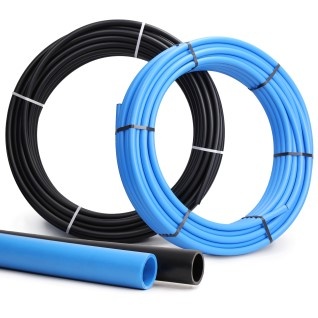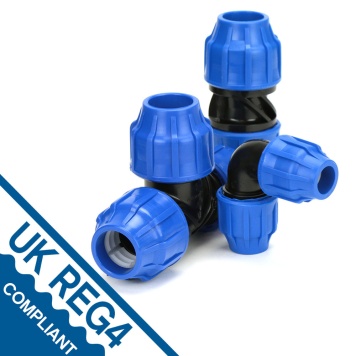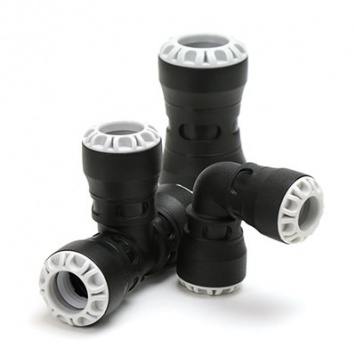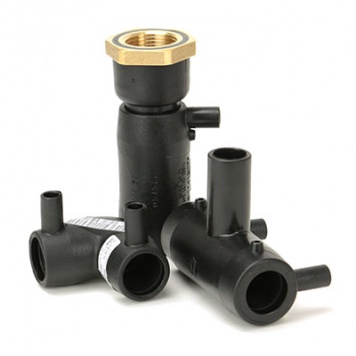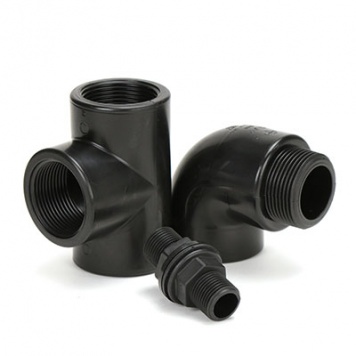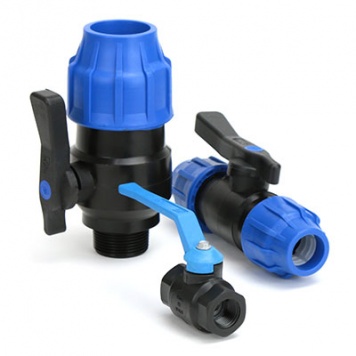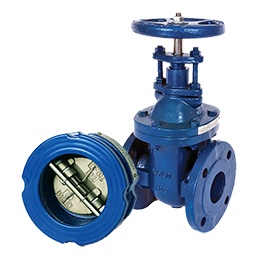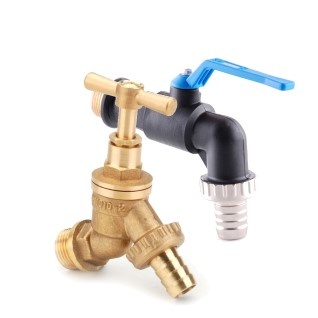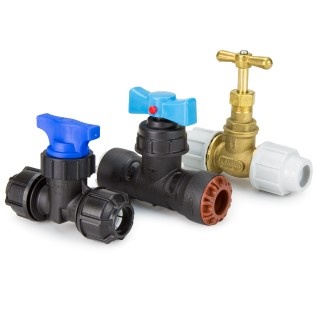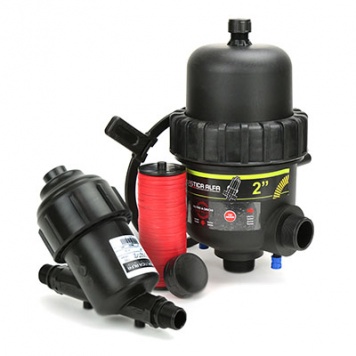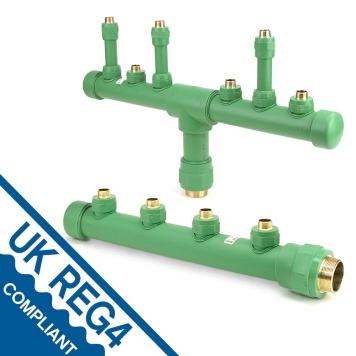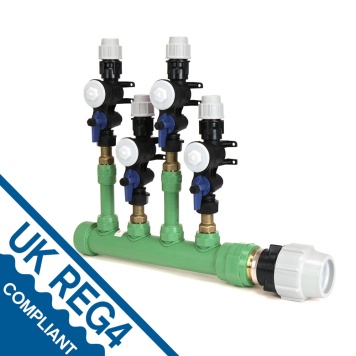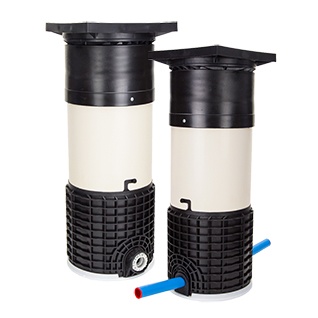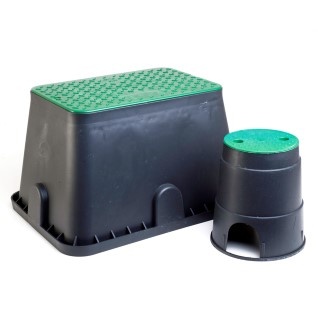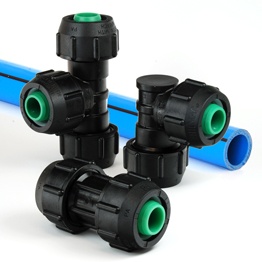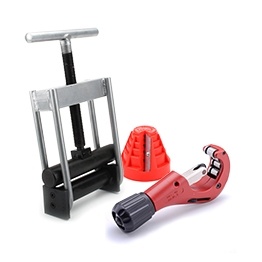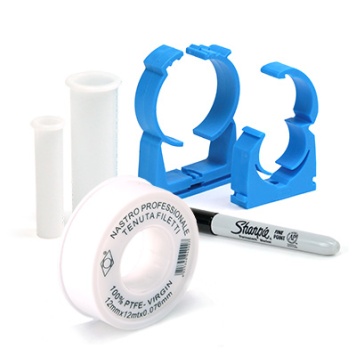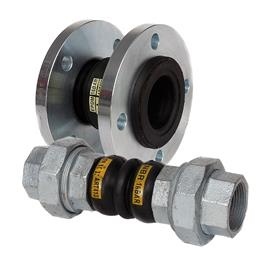- Home
- MDPE
MDPE
![]()
Sizes 20mm to 180mm MDPE water pipework, UK next day delivery, huge discounts online, excellent customer service, call us on 01794 835835.
MDPE, or medium-density polyethylene, is ideal for water pipework as it is light, durable, and resistant to corrosion and stress cracking.
As a pipework system, MDPE was specifically designed to carry water for human consumption. Therefore, no contaminants can be present, either through the build-up of bacteria or from rust generated through corrosion. MDPE is manufactured with a smooth bore, to prevent the accumulation of bacteria. As a plastic, it obviously won't corrode, but it is also resistant to environmental degradation.
MDPE was previously known as alkathene, although that name is still used in the industry today, or is often shortened to just PE.
For more information on MDPE, check out our comprehensive MDPE Guide.
What is MDPE Pipe?
MDPE pipe stands for Medium-Density Polyethylene pipe, a type of plastic piping made from medium-density polyethylene. It is renowned for its balance of flexibility and strength, making it a preferred choice for various applications. The material's medium-density aspect, with a typical density range of 0.926–0.940 g/cm³, ensures that the pipe combines the durability required to resist stress cracking with sufficient pliability to be available in coils for easier installation.
MDPE pipes are predominantly used for distributing potable water, as their smooth internal surface inhibits bacterial buildup, ensuring clean water supply and maintaining high flow rates. In addition to water supply systems, these pipes are also utilised in irrigation and agricultural sectors due to their chemical resistance and durability.
Distinctively coloured in blue or black, MDPE pipes serve different purposes: blue pipe is used mainly for below-ground potable water lines, while black pipe, which is UV stabilised, is suitable for both above and below-ground applications. The material's robustness lends MDPE pipes a long service life, often exceeding 50 years, and provides significant resistance to freezing conditions, especially when properly installed and insulated.
Overall, MDPE pipe is a versatile, durable, and reliable choice for various piping systems, particularly water transport and distribution.
What Are The Key Features of MDPE Pipe?
- Material Integrity: Made from medium-density polyethylene, MDPE pipe boasts superior durability, flexibility, and resistance to stress cracking, making them ideal for various applications, including potable water supply.
- Versatility in Applications: Predominantly used for potable water conveyance, MDPE pipes' smooth internal surface prevents bacterial buildup, promoting clean water flow. They are also suitable for agricultural and irrigation purposes.
- Colour-Coded Convenience: Choose blue MDPE pipe for below-ground installations, ensuring safe potable water transport. Opt for black MDPE pipe for above-ground applications, benefiting from added UV protection.
- Extensive Range: Our MDPE Pipe is available in diameters from 20mm-180mm for coils and 50mm-180mm in 3-metre or 6-metre lengths.
- Longevity and Safety: MDPE pipe is not only a safer alternative to lead pipes but also offers longevity of over 50 years, minimising the need for frequent replacements.
- Fittings Compatibility: Our MDPE pipes are compatible with various fittings, including compression, push-fit, and electrofusion fittings, allowing for flexible and secure installations.
- Easy Installation: Whether you're replacing old lead pipes or installing a new water system, MDPE pipe is lightweight, easy to handle, and simple to install, ensuring a reliable water supply.
MDPE Pipe Dimensions & Ratings
- Pressure Rating (MDPE): 12.5 bar
- Pressure Rating (HDPE): 10 bar
- Standards: ISO 4427:2007, BS EN 15494:2003, BS 6572:1985, BS EN 12201
| MDPE Pipe Dimensions, Metric, BS EN 15494:2003 |
|||||
| Pipe Size (mm) | Average Bore Inside Diameter (mm) | Average Wall Thickness (mm) | Approximate Weight per Metre (kg) | PE Rating | SDR Rating |
| 20 | 15.2 | 2.4 | 0.13 | 80 | 11 |
| 25 | 20.1 | 2.5 | 0.17 | 80 | 11 |
| 32 | 25.8 | 3.1 | 0.28 | 80 | 11 |
| 50 | 40.4 | 4.8 | 0.67 | 80 | 11 |
| 63 | 50.9 | 6.1 | 1.05 | 80 | 11 |
| 90 | 78.7 | 5.7 | 1.39 | 100 | 17 |
| 110 | 96.3 | 6.9 | 2.06 | 100 | 17 |
| 125 | 109.5 | 7.8 | 2.66 | 100 | 17 |
| 160 | 140.3 | 9.8 | 4.38 | 100 | 17 |
| 180 | 158.0 | 11.0 | 5.49 | 100 | 17 |
Approvals




WRAS (Water Regulations Advisory Scheme) approval and the BSI Kitemark are important certifications for MDPE pipe, especially when they are used in water supply systems. These approvals are markers of quality and compliance, ensuring that the products meet specific safety and performance standards. Here's what each certification entails:
WRAS Approval
WRAS approval is a certification granted by the Water Regulations Advisory Scheme in the UK. It signifies that a product complies with the high standards set out by UK water regulations and bylaws. This approval is crucial for products that come into contact with drinking water, including pipes, fittings, and valves. Here are key points about WRAS approval:
- Safety and Health: Products with WRAS approval have been tested to ensure they do not contaminate the water and are safe for human consumption.
- Material Quality: Tests include checking materials to ensure they are of a high standard and suitable for prolonged contact with drinking water without degradation.
- Installation Compliance: Ensures that the product can be installed in a manner that complies with water fittings regulations, safeguarding against misuse or incorrect installation that could lead to water contamination or wastage.
BSI Kitemark
The BSI Kitemark, issued by the British Standards Institution, is a widely recognised quality and safety mark that shows a product conforms to British, European, or international standards. For MDPE pipes, the BSI Kitemark demonstrates compliance with specific standards such as BS EN 12201, which covers plastic piping systems for water supply:
- Quality Assurance: The Kitemark indicates that not only is the product manufactured to comply with the standards, but it is also consistently produced to this quality, as BSI regularly audits the manufacturing processes.
- Product Testing: Products must undergo rigorous testing to achieve the Kitemark certification. This includes performance testing under various conditions to ensure durability and functionality.
- Consumer Trust: A BSI Kitemark is a sign of trust and reliability for consumers, indicating that the product will perform as stated and has passed thorough testing.
What is Regulation 4 of The Water Supply (Water Fittings) Regulations 1999?
Regulation 4 of The Water Supply (Water Fittings) Regulations 1999 is a key provision that focuses on the requirement of providing water fittings that do not cause waste, misuse, contamination, or excessive consumption of water. This regulation plays a vital role in ensuring public health, water conservation, and the integrity of the water supply. Under Regulation 4, it is essential to use only water fittings of an appropriate quality and standard. For the purposes of Regulation 4, a water fitting is of an appropriate quality or standard only if it meets one of the following criteria:
Bear an appropriate CE marking in accordance with the Directive.
Conform to an appropriate harmonized standard or European technical approval.
Conform to an appropriate British Standard or some other national specification of an EEA State which provides an equivalent level of protection and performance.
Conforms to a specification approved by the regulator.
Compliance with Regulation 4 also includes proper installation practices, regular maintenance, and prompt repairs to prevent leaks and water wastage. By adhering to Regulation 4, the regulations ensure that water fittings are safe, efficient, and environmentally responsible, promoting public health, water conservation, and the sustainability of water resources.
What is ISO 17885:2021 - Plastic Piping Systems?
ISO 17885:2021 - Plastics piping systems is an international standard that provides guidelines for the design, installation, and maintenance of plastic piping systems. It covers various aspects, including materials, dimensions, pressure ratings, and testing requirements. The standard ensures that plastic piping systems are manufactured and installed in a safe and reliable manner, promoting durability, efficiency, and environmental sustainability. Compliance with ISO 17885:2021 helps ensure the quality, performance and integrity of plastic piping systems, contributing to the safe transportation and conveyance in this instance of Water For Human Consumption, Water For Irrigation and Waste Water.
Is MDPE Pipe Known By Any Other Names?
Yes, MDPE (Medium Density Polyethylene) pipe is sometimes referred to by other names, which can vary depending on the region or specific application. Here are a few alternative names commonly used for MDPE pipe:
- Alkathene Pipe: This term was traditionally used in the UK for MDPE and other polyethylene pipe systems. "Alkathene" was originally a brand name associated with polyethylene products but has since become a generic term, particularly in older literature or among those in the industry for a long time.
- PE Pipe: MDPE is a type of Polyethylene, so it is often simply referred to as PE pipe. Polyethylene comes in various densities, so the term PE pipe might be qualified as HDPE (High-Density Polyethylene) or LDPE (Low-Density Polyethylene) to distinguish between the types.
- Poly Pipe: Short for "polyethylene pipe," this term is commonly used, especially in Australia and North America. It is a generic name for pipes made from any type of polyethylene.
- Blue or Black Poly: In some regions, MDPE pipes are referred to by their colour when the context is clear, especially in specific applications like water (blue) and gas (yellow) distribution.
Each of these terms might be used interchangeably with MDPE, depending on the context, though it’s always good to specify the type of polyethylene if clarity is needed, given the different characteristics of LDPE, MDPE, and HDPE.
Is MDPE Pipe Suitable For Drinking Water?
Yes, blue MDPE water pipe is specifically designed and widely used for drinking water applications. The blue colour of the pipe is an industry-standard code that signifies its suitability for transporting potable water. Here are key reasons why blue MDPE water pipe is suitable for drinking water:
- Material Safety: MDPE is a non-toxic material that does not leach harmful substances into the water, ensuring that the water remains safe for human consumption.
- Corrosion and Chemical Resistance: MDPE is resistant to corrosion and many chemicals, which means it does not degrade easily and maintains the quality of the water passing through it.
- Durability and Flexibility: MDPE pipes are known for their durability and flexibility, which makes them less likely to crack or break under pressure or due to environmental factors like ground movement.
- Certifications: Blue MDPE pipes must meet certain standards and regulations that certify them as safe for potable water use. In the UK, for instance, these pipes are typically required to comply with BS EN 12201 for plastic piping systems for water supply and can have WRAS (Water Regulations Advisory Scheme) approval, confirming that they meet strict hygiene standards and do not affect water quality.
Because of these properties, blue MDPE pipe is a reliable choice for water distribution networks, both for domestic and commercial uses, ensuring a safe and efficient water supply system.
Do I Need Pipe Inserts For MDPE Pipe?
Yes, pipe inserts (also known as stiffeners or liners) are typically required when using MDPE pipe, especially when making connections with compression fittings. Here's why they are important and how they are used:
Importance of Pipe Inserts in MDPE Pipes
- Structural Support: Pipe inserts provide internal support to the MDPE pipe. They prevent the pipe from collapsing or deforming when the compression fitting is tightened. This is particularly crucial in maintaining the integrity of the connection, ensuring it remains tight and leak-free.
- Seal Integrity: Inserts help to ensure that the O-ring or seal within the fitting can make full, uninterrupted contact with the pipe surface. This prevents potential paths for leaks, enhancing the seal's effectiveness.
- Pressure Maintenance: For systems that operate under pressure, inserts are vital in helping the pipe withstand internal pressures without distorting. This distortion could otherwise lead to joint failures or leaks.
How to Use Pipe Inserts:
- Select the Correct Size: Choose a pipe insert that matches the diameter of the MDPE pipe you are using. Incorrect sizing can lead to poor fits and potential leaks.
- Prepare the Pipe: Before inserting, ensure the end of the MDPE pipe is cut straight and clean from any burrs or debris. A clean, smooth pipe end helps in fitting the insert properly.
- Insertion: Slide the insert into the pipe end. It should fit snugly inside the pipe without excessive force. Ensure it is pushed in all the way to the base of the fitting area to provide full support when the compression fitting is applied.
- Connection: After inserting the stiffener, the pipe can be connected using the chosen fitting (e.g., compression fitting). Follow the manufacturer's instructions for tightening to ensure a secure and effective seal.
Using pipe inserts is generally recommended for all types of pressurised applications and is often mandatory as per installation guidelines and standards. Always check with the pipe and fitting manufacturer's recommendations to ensure compliance with their specific requirements and to guarantee a safe installation.
Can MDPE Pipe Be Used Above Ground?
Yes, MDPE (Medium Density Polyethylene) pipe can be used above ground, and black MDPE pipe is particularly suited for this application. Black MDPE pipe is ideal for above-ground settings due to the following considerations:
- UV Resistance: Black MDPE pipes are manufactured with carbon black as a UV stabiliser, which provides excellent protection against degradation from ultraviolet light. This makes black MDPE the preferred choice for above-ground applications as it can withstand prolonged exposure to sunlight without sustaining damage.
- Temperature Considerations: While MDPE has a good range of temperature tolerance, black MDPE's composition helps it resist the effects of temperature fluctuations better than other colours. This resistance ensures that the pipe maintains its integrity and functionality in various environmental conditions.
- Mechanical Protection: Although MDPE is durable, above-ground pipes are more susceptible to physical damage. Black MDPE pipes are robust and resistant to impact and abrasion, making them more suitable for exposed conditions where physical contact might occur.
- Support and Installation: It’s essential to install black MDPE pipe with proper support to prevent sagging and stress. Use appropriate support brackets or clips at regular intervals as specified by the manufacturer to ensure stability and maintain the pipe's lifespan.
- Regulatory Compliance: Always adhere to local building codes and regulations when installing any MDPE pipe above ground. Black MDPE pipes often meet these requirements due to their enhanced properties, including UV resistance.
How Is MDPE Pipe Measured?
MDPE pipes are classified based on their outer diameter, which is always measured in millimetres (mm). The outer diameter is the most critical dimension as it dictates the size of the fittings and accessories required for a proper installation. This measurement ensures that all components in a piping system fit together correctly without leaks.
Metric Sizes
In the UK, MDPE pipes are sold in metric sizes only. This standardisation simplifies the selection process, ensuring that all parts of the plumbing or water supply system are compatible. Common sizes for MDPE pipe might include diameters such as 20mm, 25mm, 32mm, 40mm, 50mm, and 63mm, among others. Each size corresponds to a specific outer diameter, which is used to match pipes with the appropriate fittings.
How Do You Cut MDPE Pipe?
For effective and precise cutting of MDPE pipe, consider using:
Ratchet Cutter: A ratchet cutter is designed with a sharp, curved blade and a ratcheting mechanism that allows you to make a clean cut with minimal effort. This tool is particularly effective for cutting smaller to medium-sized pipes and is excellent for making quick, clean cuts.
We recommend:
Easycut Plastic Pipe Cutter: Light duty for use up to 42mm pipe
Professional Plastic Pipe Cutter: Heavy duty for use up to 63mm pipe
Rotary Pipe Cutter: A rotary pipe cutter encircles the pipe and uses a circular blade to cut through it. This tool is excellent for achieving a very straight and precise cut.
We recommend:
Professional Wheel Pipe Cutter: Suitable up to 76mm
Large Diameter Professional Wheel Pipe Cutter: Suitable up to 170mm
Steps to Cut MDPE Pipe Using Ratchet and Rotary Cutters:
- Measure and Mark: Accurately measure the required length of the MDPE pipe. Mark the cutting point clearly around the circumference of the pipe to ensure an even cut.
- Secure the Pipe: Secure the pipe to prevent it from moving during the cutting process. Use a vice or similar tool, but be careful not to deform the pipe by over-tightening.
- Cutting the Pipe:
- Using a Ratchet Cutter: Place the jaws of the ratchet cutter around the marked area on the pipe. Squeeze the handles together; the ratchet mechanism will advance the blade through the pipe with each squeeze until the pipe is cut through.
- Using a Rotary Pipe Cutter: Position the rotary cutter around the pipe at the marked line. Tighten the blade slightly against the pipe’s surface. Rotate the cutter around the pipe, gradually tightening the knob after each rotation. Continue until the pipe is fully severed.
- Deburr the Pipe: Regardless of the cutting tool used, the pipe may have some burrs or slight deformities at the cut edge. Use a deburring tool or fine-grit sandpaper to smooth these out. This is crucial for ensuring a proper fit and avoiding damage to any fitting's seals.
- Check the Cut: Inspect the cut to confirm it is straight and smooth. This ensures that the pipe will fit well with other components and maintain a leak-free system.
How Do You Join MDPE Pipe?
Joining MDPE pipe, widely used for water and gas distribution due to its durability and flexibility, involves specific steps and tools to ensure a secure and leak-proof connection. There are several methods to join MDPE pipes, with the most common being electrofusion and mechanical fittings. Here’s a brief overview of how to join MDPE pipe using these methods:
- Using Electrofusion:
- Prepare the Pipe: Cut the pipe straight and clean the ends thoroughly. Ensure there are no contaminants on the surface. Use a pipe scraper or peeling tool to remove the outer layer of the pipe's end to expose fresh material. This step is crucial for a good fusion.
- Mark the Insertion Depth: Mark the depth of insertion on the pipe end to ensure it enters the fitting to the correct depth.
- Clamp the Pipe: Use an appropriate clamp to hold the pipe and the fitting in alignment during the fusion process.
- Electrofusion: Slide the electrofusion fitting onto one end of the pipe or align it between the two pipe ends. Connect the electrofusion fitting to the electrofusion processor (control unit), which will provide the correct amount of electrical energy to heat the coils inside the fitting. Start the fusion process following the manufacturer's instructions. The fitting will heat up and melt the pipe's inner surface, creating a strong joint as it cools.
- Cooling Time: Allow the joint to cool down for the manufacturer's recommended time before moving or testing the pipe
- Using Mechanical Fittings:
- Prepare the Pipe: Cut the pipe cleanly and ensure it's free from dirt and debris. The cut should be square to the pipe's axis.
- Insert the Pipe Liner: For compression fittings, insert a pipe liner into the MDPE pipe end. This stiffener prevents the pipe from collapsing when you tighten the fitting.
- Attach the Fitting: Slide the nut, followed by the split ring and O-ring, onto the pipe. Then insert the pipe into the fitting until it reaches the stop. Tighten the nut by hand and then use a wrench to ensure a secure and leak-proof connection.
For all methods, it's crucial to follow the manufacturer's specific instructions regarding temperatures, pressures, and cooling times to ensure a strong and effective joint. Additionally, using proper safety equipment and ensuring a clean working environment are essential for a successful MDPE pipe installation.
What Is The Difference Between Black & Blue MDPE Pipe?
Black and blue MDPE (Medium Density Polyethylene) pipes are both widely used in various piping systems but are differentiated primarily by their intended applications, which are indicated by their colour:
Blue MDPE Pipe:
- Intended Use: Blue MDPE pipes are primarily used for the distribution of potable (drinking) water. The blue colour universally signifies that the contents are safe for human consumption.
- UV Resistance: Although somewhat UV resistant, blue MDPE pipes are usually not as UV resistant as black MDPE pipes. They are generally intended for underground use where UV exposure is minimal. However, some blue MDPE pipes may have UV stabilisers added depending on the manufacturer and specific product.
- Availability: Available in diameters of 20mm-180mm. Lengths of 6 metres. Coils from 25 metres to 150 metres.
- Certifications: Blue MDPE pipes must meet specific standards that certify them for potable water use. In the UK, for example, they need to comply with regulations such as those from WRAS (Water Regulations Advisory Scheme).
Black MDPE Pipe:
- Intended Use: Black MDPE pipes are often used for non-potable water applications such as irrigation, or for carrying other fluids like gas. The black colour indicates that the pipe is for general or utility use, and not specifically for drinking water.
- UV Resistance: Black MDPE pipes are imbued with carbon black, which acts as a UV stabiliser. This makes them ideal for above-ground applications where exposure to sunlight is a concern. The carbon black extends the lifespan of the pipe when exposed to UV light.
- Availability: Available in diameters of 20mm-180mm. Lengths of 6 metres. Coils from 25 metres to 150 metres.
For more information on MDPE, check out our comprehensive MDPE Guide.
Chemical Resistance


If you require any further information, our excellent customer service team is here to help so please call us on 01794 835835.


